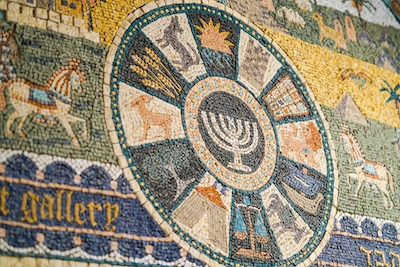Chapter 5 of Bava Batra, which begins on today’s daf, opens with a mishnah about which accoutrements of a ship are included in its sale. The rabbis of the Talmud use this mishnah as a jumping off point to discuss the kinds of fantastical things that seafarers report seeing.
Rabba said: I have seen a day-old antelope as large as Mount Tabor. And how large is Mount Tabor? It is four parasangs. And the length of its neck was three parasangs, and the place where his head rests was a parasang and a half. It excreted and dammed up the Jordan.
For context, a Persian parasang is about 3.5 miles. An enormous baby antelope as large as a mountain nearly 14 miles high? Of course its excrement would stop up a river!
And Rabbah bar bar Hana said: I have seen a certain frog as large as the fort of Hagronya. And how large is the fort of Hagronya? As large as 60 houses. A dragon came and swallowed it. A raven came and swallowed the dragon, and flew up and sat in a tree. Come and see how great is the strength of the tree!

Help us keep Jewish knowledge accessible to millions of people around the world.
Your donation to My Jewish Learning fuels endless journeys of Jewish discovery. With your help, My Jewish Learning can continue to provide nonstop opportunities for learning, connection and growth.
It’s the circle of life, ending with a majestic tree that could support the weight of a mighty raven, large enough to swallow a dragon that can swallow a fort the size of 60 houses.
Rabbah bar bar Hana’s report reads like an early version of the Passover classic Had Gadya. But lest you think this is just a post-seder drinking song, the Talmud here brings some corroboration for Rabbah bar bar Hana’s account:
Rav Pappa bar Shmuel said: If I had not been there, I would not believe it.
Let’s look at one more example from today’s daf, and then reflect on what is going on here.
And Rabba bar bar Hana said: Once we were traveling in a ship and we saw a certain fish (kvara) in whose nostril a mud eater (a type of insect) had sat (killing it). And the waters thrust the fish and threw it upon the shore. And 60 walled cities were destroyed by the fish, and 60 walled cities ate from it and another 60 walled cities salted its meat. And from one of its eyeballs they filled 300 flasks of oil. And when we returned there after 12 months had passed, we saw that they were cutting beams from its bones, and they had set out to rebuild those districts.
Talk about a fish story! This last report describes a fish so large that the size and weight of its corpse destroyed 60 cities, and its flesh and bones could feed another 120!
Drs. Reuven Kipperwasser and Dan Shapira have noted important parallels between all three of these stories and a Zoroastrian text called the Bundahishn. This text, which preserves some Zoroastrian traditions from the time of the rabbis of the Talmud, includes a tale about a three-legged donkey as big as Mount Xwanwand, an enormous and malevolent frog, dragons, a majestic world-tree and a primordial kar-fish (which sounds an awful lot like the Aramaic word kvara). It seems that these mythical figures were shared across religious lines in ancient Babylonia.
These stories read like the tall tales told by sailors over a round of beer at a local tavern. But whether or not we read them as historically accurate reports of things seen at sea, they can still tell us important things about the wonders of the world, as the rabbis imagined it, and about the kinds of relationships that developed across religious lines — both on distant voyages and closer to home.
Read all of Bava Batra 73 on Sefaria.
This piece originally appeared in a My Jewish Learning Daf Yomi email newsletter sent on September 6, 2024. If you are interested in receiving the newsletter, sign up here.



